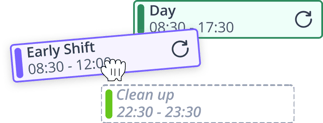This in-depth guide will help you understand swing shifts, their applications, and their implications for employees and businesses.
What are swing shift hours?
Swing shift hours are work shifts that start in the afternoon and finish at night, right between the typical day shift and night shift. Think of it as the “middle child” of shift work.
Instead of clocking in at 9 am, swing shift workers might start around 2 or 3 in the afternoon and wrap up closer to 10 or 11 pm. This type of shift is common in industries that run beyond standard office hours like hospitality, healthcare, manufacturing, retail, and customer support.
Swing shifts help employers cover busy evening periods, manage 24/7 operations, or balance staffing between day and night teams.
What hours are considered swing shift hours?
There’s no one-size-fits-all, but swing shifts usually fall somewhere in this range:
📌 Typical swing shift hours:
- 2:00 pm to 10:00 pm
- 3:00 pm to 11:00 pm
- 4:00 pm to midnight
Some companies adjust swing shifts to suit their peak hours; especially if they're open late or operate across time zones.
If you’re in the UK, remember that these shifts must still comply with Working Time Regulations (e.g. rest periods, breaks, and weekly hour limits). And in the US, you’ll want to watch for overtime rules, especially in states with stricter labour laws.
Type of swing shift hours examples
Not all swing shifts are created equal. Depending on the industry, staffing needs, and business hours, swing shifts can look a bit different. Here are the most common types:
Fixed swing shift
The employee works the same afternoon-to-evening hours every day.
- Example: A restaurant server works 3:00 pm to 11:00 pm, Tuesday to Saturday.
- Best for: Stability, consistent rotas, and employees who prefer routine.
Rotating swing shift
The shift rotates, sometimes it’s swing, sometimes day or night. These can rotate weekly or fortnightly.
Example: A factory worker does:
- Week 1: 7:00 am to 3:00 pm
- Week 2: 3:00 pm to 11:00 pm
- Week 3: 11:00 pm to 7:00 am
✅ Best for: 24/7 operations needing full coverage with a shared load across shifts.
⚠️ Consider: Rotating shifts can be tough on sleep and work-life balance.
Split swing shift
One shift split into two parts, usually with a long break in between.
Example: A stadium cleaner works:
- 2:00 pm to 6:00 pm (pre-event prep)
- Break
- 9:00 pm to 1:00 am (post-event clean-up)
✅ Best for: Events, transport, or cleaning services with “peak” activity windows.
⚠️ Consider: Breaks between shifts may count as rest periods under UK law—watch your scheduling.
👥 On-call or relief swing shift
Employees are on standby for the swing period, filling in as needed.
Example: A retail supervisor is “on call” from 2:00 pm to 10:00 pm if footfall surges or someone calls in sick.
✅ Best for: Covering absences or sudden demand spikes.
⚠️ Consider: In the UK, this might fall under zero-hours or casual contract rules—watch for new 2025 regulations on fair scheduling and “reasonable notice.”
Legal framework for swing shift hours
While running swing shifts you wanna make sure that you're staying on the right side of employment law. Here's what you need to know on both sides of the pond.
🇬🇧 United Kingdom
Swing shifts are legal, but they must comply with the Working Time Regulations 1998, plus some newer updates coming in.
Key rules to follow:
- Maximum average hours: 48 per week (averaged over 17 weeks) unless the employee signs an opt-out agreement.
- Rest breaks:
- At least 20 minutes for every 6+ hour shift
- 11 hours of rest between shifts
- 1 day off per week (or 2 in a fortnight)
- Night work alert: If a swing shift ends after 11 pm, the role may count as “night work”—in which case, employees:
- Must not work more than 8 hours in any 24-hour period, on average
- May need free health assessments if working regular night shifts (this will likely become mandatory under upcoming 2026 legislation)
- New rights coming (2025–2026):
- Right to reasonable notice for shift changes or cancellations
- Compensation if a scheduled shift is cancelled last-minute (especially for zero or low-hours workers)
- Extended tribunal time limits for scheduling disputes (6 months)
⚠️ If you’re using swing shifts with zero-hours or casual workers, these new rules will apply. Now’s the time to review how you notify them of shifts and cancellations.
🇺🇸 United States
There’s no federal law against swing shifts, but compliance depends on your state.
Federal (FLSA) requirements:
- Overtime: Must pay time and a half for hours worked over 40 per week (unless exempt)
- No required breaks, but some states (e.g. California) do require meal/rest breaks
- Swing shifts are legal, but employers must track hours carefully and ensure overtime is paid correctly
State-level examples:
- California: Requires:
- A 30-min unpaid meal break if working more than 5 hours
- Overtime pay after 8 hours per day
- Predictive scheduling laws in some cities (e.g. San Francisco)
- New York & Washington: Have growing rules around fair scheduling; advanced notice, penalties for last-minute changes, and limits on “clopening” (close-late/open-early) shifts
💡 Tip: Always check your state or city’s latest wage and hour laws. Predictive scheduling, paid leave, and split shift premiums are all gaining traction.
Pros and cons of swing shift hours
Swing shifts can be a game-changer for coverage, but they’re not for everyone. Here’s what you should know before you build your rota.
✅ Pros of swing shifts
- Better coverage for busy evening hours: Perfect for retail, customer service, and hospitality when footfall or call volume peaks after 5 pm.
- Keeps operations running smoothly: If you run 24/7 (like in healthcare, security or manufacturing), swing shifts help bridge the gap between the day and night teams.
- Flexibility for employees: Some people love swing shifts; late risers, students, or those juggling daytime responsibilities. It’s a win-win if they get to skip the morning commute too!
- Potential for increased productivity: Fewer distractions in the late afternoon and evening can boost focus and task completion, especially for roles like IT support or back-office operations.
❌ Cons of swing shifts
- Harder to recruit for: Not everyone wants to work evenings; especially if it clashes with family or social time.
- Fatigue and health concerns: Swing shifts that end late (10 pm or later) can throw off sleep routines. If shifts rotate, employees may struggle to adjust, affecting wellbeing.
- Management challenges: Managers need to be around or delegate authority if swing workers need supervision or support. That means staggered leadership or clear escalation paths.
- Legal and compliance risks: Forget to give proper rest breaks or notice? You could end up in breach of working time rules.
Manage swing shift hours better with Shiftbase
Managing swing shifts manually can be tricky, especially when you're dealing with last-minute changes, availability issues, or trying to keep everyone compliant with labour laws. That's where Shiftbase comes in.
With our all-in-one workforce management software, you can build smarter rotas, track working hours, and handle absences, all in one place. Our employee scheduling tool makes it easy to plan swing shifts weeks in advance (or tweak them last-minute), while factoring in employee availability and contract rules.
Need to keep an eye on actual hours worked? Our time tracking feature helps you monitor clock-ins and outs, so you're always on top of overtime or late finishes.
And when someone's off sick or on holiday? Absence management makes it simple to adjust your work schedule without scrambling for cover.
💡 Bonus: You’ll avoid the common compliance pitfalls, like overworking your staff or skipping legally required breaks.
👉 Ready to simplify swing shift scheduling?
Try Shiftbase free for 14 days—no strings attached, no credit card required. Just smarter scheduling from day one.

- Create rosters quickly
- Insight into labor costs
- Access anywhere via the app

